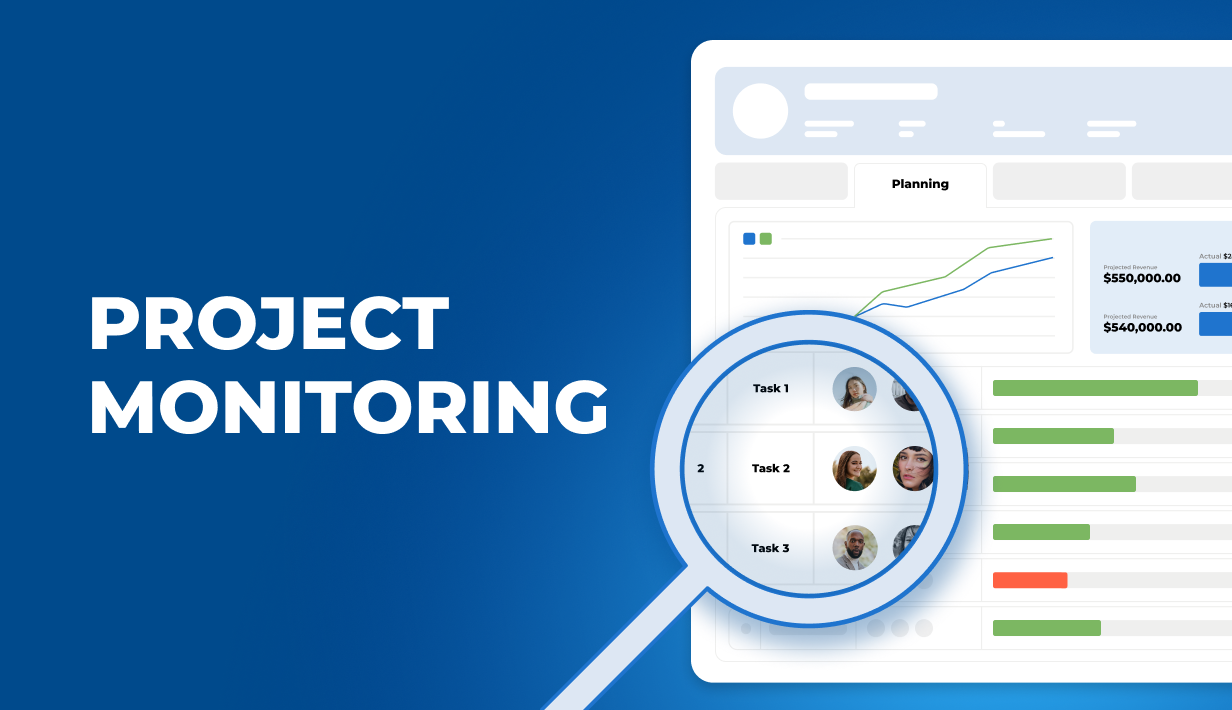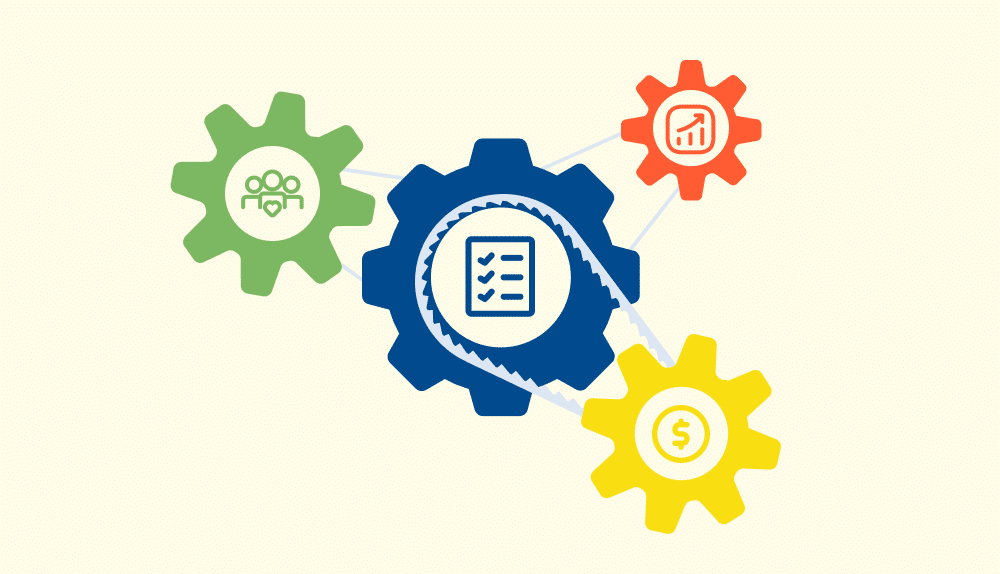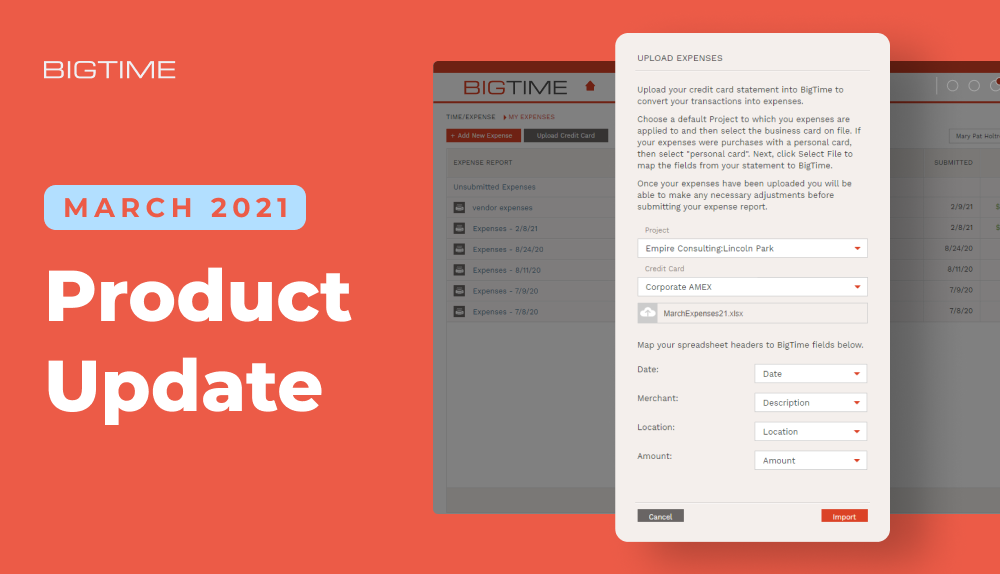In the fast-paced world of project management, delivering on time and within budget is more than a goal—it’s a necessity. Yet, even the most meticulously planned projects can veer off course without a system in place to track progress, flag risks, and ensure accountability. That’s where project monitoring comes in.
In this article, we’ll explore the fundamentals of project monitoring and controlling, the tools and techniques that drive results, and the best practices that seasoned project managers swear by. Let’s dive into how you can transform monitoring from a routine task into a strategic advantage.
In this article, you’ll learn:
- What is project monitoring
- What does a project monitoring process look like
- What project KPIs should you keep an eye on
- What are the common challenges you might encounter in the process.
What Is Project Monitoring?
Project monitoring is the ongoing process of systematically tracking, reviewing, and evaluating a project’s progress against its planned objectives, timelines, and budget. It involves collecting real-time data on key performance indicators, analyzing that data to identify variances or risks, and ensuring that the project stays aligned with its goals.
Why Is Project Monitoring Important?
Project monitoring is essential because it provides the visibility and control needed to keep a project on track. By regularly measuring progress against plans, project teams can quickly identify deviations in scope, schedule, cost, or quality—and take corrective action before small issues turn into major setbacks. This proactive oversight reduces the risk of project failure, supports better decision-making, and helps ensure that resources are being used effectively.
Additionally, project monitoring enhances accountability by keeping all stakeholders informed and aligned. It enables clear communication, fosters trust, and allows leaders to demonstrate progress toward strategic goals. Ultimately, monitoring is not just a technical function—it’s a vital management discipline that directly contributes to a project’s success and the organization’s long-term performance.
Key Performance Indicators in Project Monitoring Process
Key Performance Indicators (KPIs) are measurable values that help assess how well a project is progressing toward its objectives. In project monitoring, they provide clear insights into performance, enabling timely decisions and corrective actions.
The most common key performance indicators used in project monitoring include:
- Schedule Performance Index, which measures how efficiently time is being used compared to the original schedule by dividing earned value by planned value. Any value below 1 indicates that the project has been delayed.
- Cost Performance Index evaluating the cost efficiency of the project. It is calculated by dividing earned value by actual project costs. CPI <1 signals overspending, while CPI >1 suggests cost efficiency.
- Budget variance shows project managers the difference between planned and actual project spending, helping identify any variances early and prevent sudden drops in profitability.
- Schedule variance, which differences between progress planned in project schedule and actual progress.
- Resource utilization rate, which tracks how effectively project resources (especially human resources) are being used.
- Milestone achievement rate. It measures the percentage of completed milestones versus the planned milestones.
- Quality metrics for measuring defect rates, rework levels, or client satisfaction related to deliverables. These might differ between projects and need to be defined individually with project stakeholders for each deliverable.
How To Monitor a Project? A Complete Guide to Project Monitoring Process
A well-structured project monitoring process is essential for keeping projects aligned with objectives, identifying deviations early, and making informed decisions. But how do you implement project monitoring in your business?
Below you’ll find a complete, step-by-step project monitoring process that will help you achieve that – and more.
Define What To Monitor
Before tracking anything, determine what success looks like. To do that, identify:
- Key performance indicators (KPIs) you can use to measure progress and project success.
- Project objectives, milestones and deliverables. To do that, identify the project scope. Then, start with the general project goals and divide them into individual project stages and tasks for the best results.
- Quality standards and project risks. Define what constitutes acceptable quality for each deliverable and establish limits for tolerable risk.
- Resource usage metrics, including team capacity, hours worked, and resource allocation. Effective resource monitoring helps avoid burnout, identifies bottlenecks, and optimizes utilization rates.
Set Up Monitoring and Controlling Tools
Once you’ve defined what to monitor, the next step is to establish the systems that will capture and track that information.
While many companies still use Excel spreadsheets to oversee project performance, such endless documents rarely provide them with a complete overview of all the data, and if they do, they require hours of manual labor. For that reason, many leading professional services companies have implemented project management software to remedy that situation.
Project management software (such as BigTime) helps companies monitor projects by providing real-time visibility into tasks, timelines, budgets, and resource utilization—all in one centralized platform. It enables teams to track progress against plans, identify bottlenecks, and respond to issues quickly with data-driven insights.
This is, however, not the end of the list of benefits of project management software. It also offers automated reporting, alerts, and dashboards streamline communication and ensure stakeholders stay informed, ultimately improving project control and accountability.

Focus on Data Collection
To effectively monitor a project, it’s essential to collect and analyze accurate, real-time data throughout its lifecycle. For that reason, project monitoring involves tracking:
- Project’s progress with time tracking software,
- The current use of project budget with not only hourly rates, but also overheads and additional project costs.
- Resource utilization rates, as well as resource allocations themselves, as they might change unexpectedly over the course of the project, causing delays in its execution.
- Issues, requests and any other events that might lead to changes in the initial project scope.
Analyze Project Performance Data
Once collected, project data should be analyzed against the established baseline to assess how effectively the team is meeting milestones, controlling costs, and sustaining productivity. Identifying early warning signs—such as delays, scope changes, or resource constraints—enables timely, proactive intervention before issues escalate and impact project’s progress or its final outcomes.
To achieve the most accurate and actionable insights and automate data collection, leverage advanced reporting tools to compare planned versus actual performance. By generating detailed reports on project progress and budget, you can track deviations across each phase, address emerging challenges in real time, and help ensure the success of the entire project.
Implement Corrective Actions
To ensure both your current and future projects benefit from project management monitoring, ensure that the conclusions drawn from each project execution will have a real impact on the next project plan you create. To do that, conduct a retrospective to answer the following questions:
- What monitoring methods worked well?
- Were any metrics irrelevant or missing?
- How can the process be improved in future projects?
Then, use the lessons to avoid recurring challenges, strengthen project monitoring and improve project portfolio management across your organizations.
Best Practices For Project Monitoring Process
Monitoring a project isn’t just about tracking deadlines—it’s about enabling proactive management, optimizing resources, and keeping everyone aligned toward shared goals. To get the most value from your monitoring efforts, consider these best practices:
Improve Communication and Transparency
Contrary to popular belief, monitoring project’s status should involve more people than just a single project manager. By ensuring that regular updates are shared with both the team and stakeholders, managers can build trust, reduce confusion, and manage potential risks more effectively than ever before.
Importantly, with project management software available on the market, they also do not have to calculate key metrics manually and create reports in spreadsheets; instead, they can share automatically generated summaries to help other monitor project’s life cycle with ease.
Analyze and Improve Processes
Seeing project outcomes is not the end of the journey; it is just the first step towards improved project performance and better processes. Don’t just collect the data; instead, use it to review what’s working and what’s not. Use performance data to identify bottlenecks, recurring issues, or inefficiencies in resource management, project planning, and cost management. Apply those insights to refine workflows and improve execution in future phases or projects to ensure your project remains successful from start to finish.
Use Project Monitoring Tools
Project lifecycle is long and filled with challenges. Fortunately, with the modern technology, you do not have to monitor it manually. To relief yourself of that burden, leverage digital project management tools to collect and analyze data on people, projects and finances in the real time. These tools centralize project information, automate reporting, and make it easier to identify trends, track performance, and make informed decisions quickly.
Common Challenges in Project Monitoring
Even with the right tools and planning, project monitoring can present a variety of challenges that hinder performance and decision-making. Usually, those challenges include:
Scope Creep
One of the most common issues in project monitoring is uncontrolled changes to the project scope. When new features or tasks are added without proper evaluation or approval, it becomes difficult to track progress accurately or maintain alignment with original goals. Your project monitoring plan should take such possibility into consideration, leaving some room for unexpected changes and
Different Techniques, Formulas and Methodologies
Teams often struggle with inconsistency when using multiple monitoring methods or reporting standards. Whether it’s earned value management, critical path analysis, or agile burn-down charts, confusion can arise if everyone isn’t aligned on what techniques are being used or how metrics are interpreted. Standardize methodologies across the team to ensure clarity and comparability.
Budgeting Issues
Tracking and forecasting costs can become a challenge when expenses are not logged accurately or when estimates lack detail. Without a clear picture of spending, it’s easy to overshoot the budget or miss financial red flags. A robust cost-monitoring process that compares planned vs. actual expenditure in real time is essential.
Burdensome Reporting
While reporting is a key part of project monitoring, overly complex or time-consuming reports can drain a manager’s productivity and leave them with little time to make proactive decisions. Additionally, when overburdened, project managers might also compromise the quality of data, leading to incorrect conclusions. The solution? Streamlined, automated reporting tools that reduce the burden while maintaining visibility.
Effective Project Monitoring Starts with BigTime
Monitoring and controlling planned and actual performance of multiple projects at once is not an easy task. Fortunately, BigTime’s project management software can help you supervise the entire project team, budget, and more, without creating a single report manually.
BigTime’s project monitoring tools offer:
- A wide range of tools for project planning phase, ranging from draft allocations to scenario testing.
- Advanced resource allocation features, such as skill management, quick replacements and AI demand matching.
- Scalable project and project portfolio management for multiple project, allowing for organization-wide improvements and risk management.
- In-depth project cost management, complete with overheads, automated cost of work calculations, and live overview of key expenses.
- AI-powered reporting for quick and efficient overview of project’s progress.
- Customized invoices paired with payment system for a complete control over key transactions.
Multiple Tools? No Problem!
Importantly, you do not have to say goodbye to other tools you already know and trust. BigTime can be integrated with additional tools for accounting, time tracking, HR, project management, and more, helping project managers collect the data from all the possible sources. The result? No information gap and zero errors in key decisions.
Try BigTime Now and Turn Data Collection Into Project Successful Project Management
Turn your project management process into source of valuable data – it doesn’t have to be a chore anymore!
Book a demo with BigTime’s specialists to see how we collect and process data to provide you with AI-powered insights boosting your productivity, profitability, and project success rates.




